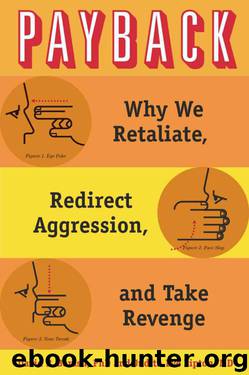Payback: Why We Retaliate, Redirect Aggression, and Take Revenge by Barash David P. & Lipton Judith Eve

Author:Barash, David P. & Lipton, Judith Eve [Barash, David P.]
Language: eng
Format: epub
Publisher: Oxford University Press
Published: 2011-04-20T22:00:00+00:00
Thus far in this chapter, we have tried to make the case that a solid line—based on the Three Rs—runs through revenge to feuding, through the personal to the social, often mediated by the behavior of unscrupulous leaders and abetted by the poisonous effects of culturally sanctioned rumination. But what happens when rumination becomes action? Take the case of ethnic rioting.
Certainly, to experience a riot is to undergo a high level of arousal. Participants, surfing on a wave of anger, adrenaline, and agitation, are overwhelmingly “in the moment” and not prone to rumination. But especially when it carries a strong ethnic flavor—with one group pitted against another—such events commonly emit more than a whiff of ruminative, redirected aggression, often fanned by unscrupulous, self-seeking leaders. For some examples, we turn to a bit of mid-twentieth-century history, events that are for the most part unfamiliar to the majority of Americans but which, precisely for that reason, are likely to be valuable because they offer the kind of clarity that comes with distance.
In 1949, riots broke out in the city of Durban, South Africa, in response to an electoral victory by the ultra-rightwing Nationalist party, which to most citizens signaled a forthcoming dramatic decline in the circumstances of black A fricans.* In the resulting communal violence, interestingly, not a single white European, neither British nor Boer, was attacked, presumably because they were considered too powerful. Instead, black African violence was directed—actually, redirected—toward South Africans of Indian descent. It is worth noting, at the same time, that redirected aggression was not the only underlying cause of the Durban riots: native Zulus and Xhosa had ongoing grievances against the Indian-Africans, whose entrepreneurial culture rendered them not only economically more successful on balance than their black African counterparts, but also direct targets of envy.17
Before the Durban riots came the equally instructive Burmese riots of 1938. Here, once again, ethnic Indians were lightning rods for accumulated anti-colonial pain and anger that were in fact more “honestly” and universally felt against white Europeans—notably, the imperial British occupiers of Burma—and that had earlier surfaced during the so-called Saya San rebellion of 1930-1931. However, the military power of the occupying British Indian Army had made these efforts futile, so† the hostility of the indigenous Burmese was redirected toward the economically successful but socially vulnerable Indo-Burmese.
The Burmese riots began when a book written by an Indian Muslim presented an unflattering image of the Buddha. Protesters demonstrating against this book turned and attacked Indo-Burmese citizens, whereupon British police forcibly quelled the near-riot. The next day, several Burmese newspapers printed a largely apocryphal story in which British police had brutalized innocent monks leading a peaceful protest. Clearly, it was the British, rather than the local Indian population, that warranted wrath.
Nonetheless, a few days later, Burmese mobs throughout the country stormed into local villages, where they proceeded to target, not British colonialists, but Indo-Burmese residents. For reasons that are unclear, however, and that in turn suggest that factors other than “simple” redirected aggression were operating, Indian Muslims were targeted more often than were Indian Hindus.
Download
This site does not store any files on its server. We only index and link to content provided by other sites. Please contact the content providers to delete copyright contents if any and email us, we'll remove relevant links or contents immediately.
The Art of Thinking Clearly by Rolf Dobelli(9929)
The 5 Love Languages: The Secret to Love That Lasts by Gary Chapman(9291)
Mindhunter: Inside the FBI's Elite Serial Crime Unit by John E. Douglas & Mark Olshaker(8708)
Becoming Supernatural by Dr. Joe Dispenza(7843)
The Road Less Traveled by M. Scott Peck(7284)
Nudge - Improving Decisions about Health, Wealth, and Happiness by Thaler Sunstein(7255)
Mastermind: How to Think Like Sherlock Holmes by Maria Konnikova(6942)
Enlightenment Now: The Case for Reason, Science, Humanism, and Progress by Steven Pinker(6878)
Win Bigly by Scott Adams(6831)
The Way of Zen by Alan W. Watts(6290)
Factfulness: Ten Reasons We're Wrong About the World – and Why Things Are Better Than You Think by Hans Rosling(4496)
The State of Affairs by Esther Perel(4491)
Gerald's Game by Stephen King(4379)
Man's Search for Meaning by Viktor Frankl(4294)
The Confidence Code by Katty Kay(4041)
Thinking in Bets by Annie Duke(4007)
The Worm at the Core by Sheldon Solomon(3327)
Hidden Persuasion: 33 psychological influence techniques in advertising by Marc Andrews & Matthijs van Leeuwen & Rick van Baaren(3300)
Enlightenment Now by Steven Pinker(3276)
